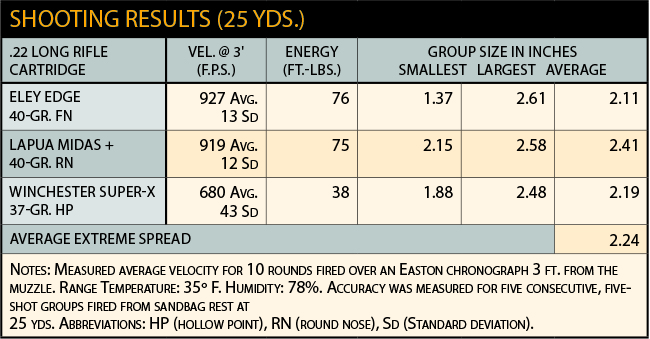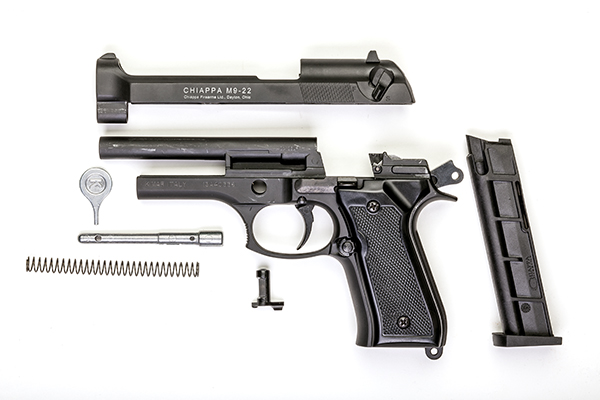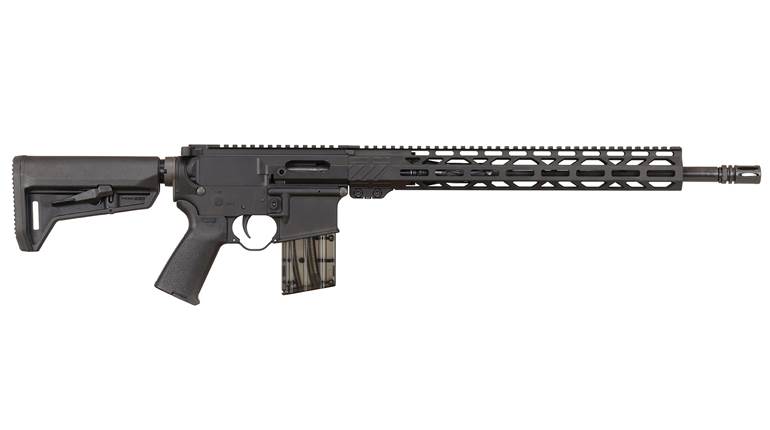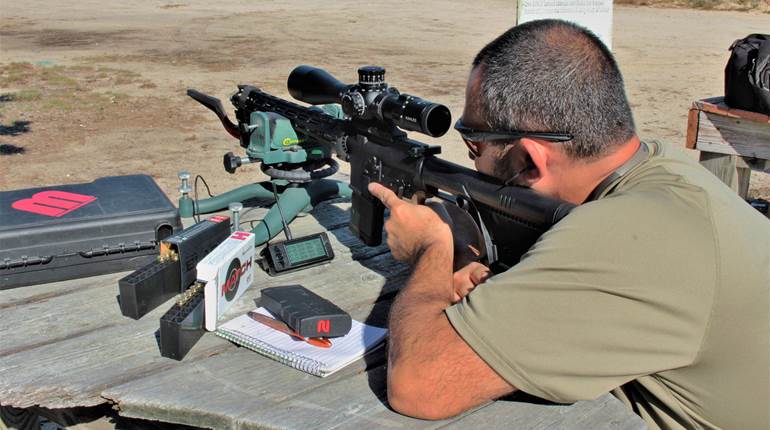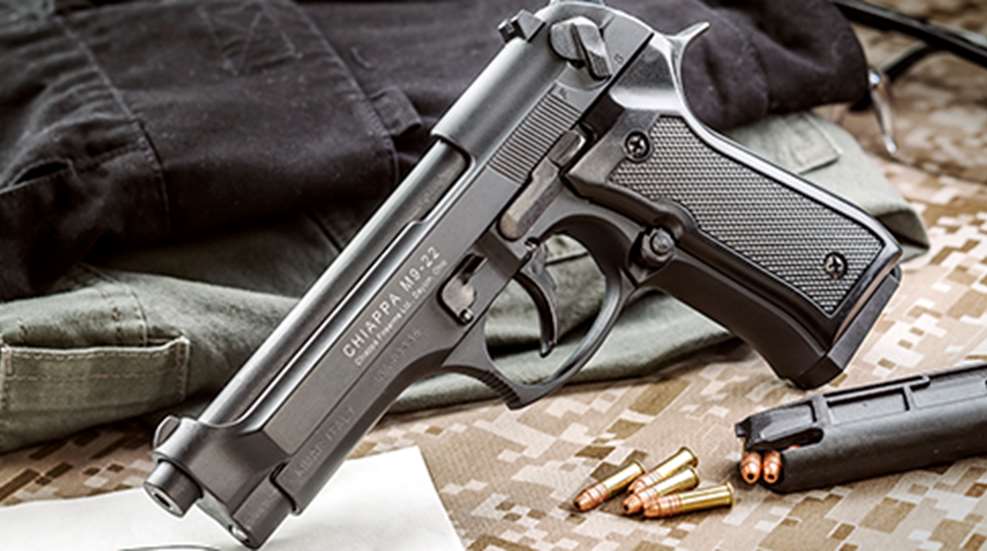
Chiappa is an Italian firm that specializes in replica firearms. Founded in 1958 by Ezechile Chiappa, the name is now an umbrella for several brands, including Armi Sport and Kimar. Chiappa’s M9-22 is made under the Kimar brand, labeled Chiappa and distributed by the U.S. firm MKS Supply. Visually it’s a Beretta 92FS, but with changes necessary for it to function as a rimfire, and it comes at a cost of around $300. It’s available in a wood- or plastic-stocked Standard model, and the plastic-stocked Tactical model with Novak-style sights and a threaded barrel.
Both models exhibit the same profile, controls, and double-action/single-action trigger as the original, but use a frame cast from a zinc alloy the company refers to as Chiappalloy. Both the process and material are sufficient for the lower pressures of the .22 Long Rifle cartridge. The gun’s 37-ounce weight is surprising, given its chambering. It’s not until wallets are weighed that the M9-22 regains its charm.
Chiappa calls its action a “fixed barrel blow-back” system. Its 51⁄8-inch barrel sleeve is cast as an integral part of the frame, complete with the feed ramp. A steel barrel insert is rifled with a 1:16-inch twist, and it’s fitted into the sleeve then secured with a set screw. The gun’s recoil spring guide rod looks rather fragile; it contains two holes in each end, the forward of which assists in assembly.
The Chiappa’s magazine release, slide release lever, decocker/manual safety, hammer, and take down lever all function like its center-fire brethren, except the decocker/manual safety and the sights are made of plastic rather than metal. Its 10-round magazine is made from plastic, save the spring, and weighs 1.5 ounces. We appreciated that it falls free of the magazine well when released.
The decocker/manual safety system is a proven one. Safely drop the hammer by rolling the ambidextrous decocking lever down. This movement disconnects and shields the firing pin by rolling it up and out of the path of the hammer. With the lever and therefore the hammer in the down position-the safe position-the trigger can still be pulled in double-action mode, thereby cocking and dropping the hammer, without the possibility of firing. If the gun is dropped accidentally, the firing pin block prevents it from reaching the primer unless the trigger is pulled. To fire, rotate the decocking/manual safety up, then either pull the trigger in double-action mode, or manually cock the hammer to fire the first round in single-action mode. Despite the decocker/safety being made of plastic, it functions fine.
The M9-.22’s trigger is a replica of the original and for that reason it is a great source of love or loathe to individual shooters. It uses a reliable system that creates cocking leverage by pulling an external, sliding trigger bar that engages the hammer when the slide is installed. Trigger pressure cocks the hammer before pushing the sear disconnect forward to release it. The double-action trigger pull measured slightly more than 12 pounds-so stout some petite shooters couldn't pull it. The trigger’s single-action pull weight measured 5 pounds, 8 ounces and had a slight bit of creep.
The steel extractor is mounted in the right side of the slide. The ejector is integral with the magazine; as the extractor pulls the case back the case rim scrapes by the magazine and ejects it. One big advantage of the open-slide design of the M9 is that jams or misfires-common to .22 Long Rifles-are reduced thanks to ample ejection port clearance. Jams that do occur are easily cleared.
The stocks are made of plastic or wood, although the wood panels make the gun’s grip 1/4 inch thicker than the plastic ones. It should be noted that this pistol’s grip frame is oversized already: The minimum measurement between the trigger and the backstrap is 2.92 inches.
At the range, the M9-22 demanded a break-in period of 200 rounds before it began to function reliably. Prior to that it would shoot, eject the spent case, send a fresh round into battery, but fail to re-cock the hammer. The frequency of the malfunction occurred less as the gun was fired, but it happened 34 times in 500 rounds. Low-recoiling Remington CBee rounds would not cycle, and it was very sensitive to hand pressure on the slide. After break-in, the M9-22 became pleasurable to shoot and proved to be accurate.
Out of the box the Chiappa shot consistently high and left. Windage was adjusted by loosening a set screw on the rear sight before drifting. Elevation, however, must be zeroed by filing the fixed plastic front sight. Both are matte-black just like the rest of the firearm.
After shooting, the gun appeared as though it was much more harshly used than it had been, no thanks to its finish that scrapes away when making contact with harder surfaces. A line on the barrel was etched by the slide. Even given the pistol's low price, Chiappa could do a better job in that regard.
Disassembly is trickier than with the original. With the takedown latch rotated and removed and the hammer hyperextended with the provided key, the slide can be pulled rearward and off the frame. During reassembly, use the key to pin the guide rod to the slide by inserting it in the guide rod’s forward hole. Then move the slide forward, taking the guide rod with it, exposing the hole in the frame to reinsert the takedown latch.
The M9-22 is an inexpensive firearm meant for low-cost fun and realistic practice-especially if you’re a fan of the Beretta.
Distributor: MKS Supply; 8611-A N.Dixie Drive, Dayton, OH 45414; (877) 425-4867
Caliber: .22 Long Rifle
Action Type: semi-automatic, fixed-barrel, blowback-operated rimfire handgun
Frame: cast zinc alloy
Barrel: 5" cast sleeve with steel insert
Rifling: six-groove, 1:16" RH twist
Sights: fixed blade front sight, windage adjustable square notch rear
Trigger: double-action, 12-lb., 8-oz. pull; single-action, 5-lb., 5-oz. pull
Stocks: plastic or wood
Overall Length: 8.65"
Height: 5.74"
Width: 1.14" (slide); 1.47" (grip)
Weight: 37 ozs.
Accessories: extra 10-round magazine, plastic case, brush, owner’s manual
Suggested Retail Price: $311 (plastic stocks); $338 (wood stocks)
